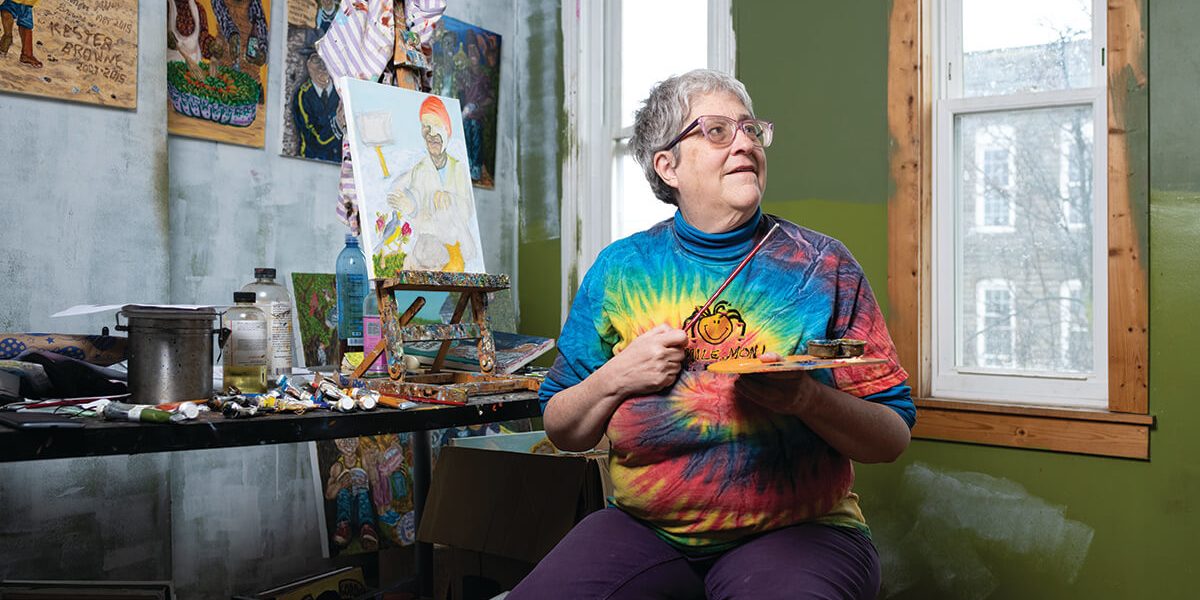Arts & Culture
Brush With Life
Self-taught Pigtown artist paints Baltimore’s victims of gun violence to heal and memorialize.
The first portrait Kimberly Sheridan painted was a close-up of James Smith III, smiling in a barber chair, and holding, symbolically, a small lamb and lion cub in his lap. On his third birthday, in 1997, at a barbershop near Sheridan’s Pigtown home, James had been shot in the head and killed as he waited with his mother to get his hair cut.
That painting, made six years ago, was a reaction, Sheridan explains—“after Congress couldn’t even pass a gun bill with background checks,” following the massacre of 20 Sandy Hook kindergarten and first-grade students. “I had become enraged. The next morning, I stood outside the Plaza Art store on Cathedral before they opened to buy supplies.”
A 58-year-old self-taught artist with impaired sight but genuine vision, Sheridan had never forgotten James. Nor had she forgotten local church custodian Ron Waggener, her best friend, killed around the corner from her home in 2004. Waggener became her second portrait a few days later. “It’s healing to paint,” she says. “It’s my way of advocating for stricter gun control laws. It’s the way I reach out to others who are grieving.”
Taking her cue from Yoko Ono, who tweeted after Sandy Hook that more than one million people in the U.S. had been killed by guns since her husband’s death, Sheridan pledged to paint a million victims of gun violence—starting with those in close proximity. “I wondered, who were these million people?” she says. “Especially the forgotten people. The ignored. What if we brought them into the light?” Today, 176 of her works fill a second-floor front room of her modest rowhouse. Colorful, joyous, and imaginative, they are informed by whatever pictures and biographical details Sheridan can cobble together. They are, overwhelmingly, portraits of people cut down before their lives had fully formed. “For some, I have to draw from mug shots,” Sheridan says. “But I paint everyone with the same sympathy. Picturing them at their best. When they were their true selves.”
Subjects include a father and son, cousins killed months apart, a pair of girlfriends, a police officer, a young man killed by police, former Councilman Kenneth Harris, and Charmaine Wilson, a 37-year-old mother of eight, who was targeted in 2017 after reporting to police that her son was being bullied. There’s also Raquan Campbell, a 15-year-old football player and honor roll student, affectionately nicknamed Ra-Ra because of his ebullient personality, who was shot 10 times in 2010. “I met with Raquan’s mother a week before Christmas this year at the Cherry Hill Shopping Center,” Sheridan recalls. “She does an annual coat drive there. She saw me coming, holding the painting, and started to cry.”
To date, Sheridan has exhibited at a Pigtown church, the former Liam’s Pub in Station North, and a small business in Canton. She doesn’t sell her work, instead offering her paintings to each victim’s family for free. She has coordinated more than a dozen such “homecomings” as she calls them, with more on the way. In terms of painting a million portraits of victims of gun violence, she says the only thing required is more artists, “There’s one in St. Louis and another in Miami doing something similar I know of,” she says. “It’s a start.”
Meanwhile, she keeps a running list of everyone killed in Baltimore. “More than 5,000 this century,” she says, shaking her head. “We are all witnesses to a slow-motion genocide of black males in this city.” Recently, Sheridan formed a nonprofit to partner with other anti-violence and family survivor organizations.
“It’s a never-ending treadmill of pain and anger leading to murder,” she continues. “We keep making little kids orphans when we kill their father, their mother, their brother and sister, and then they end up shooting someone else’s father, mother, brother, and sister.
“Why aren’t we seeing the whole picture? That’s the question I ask myself when I paint.”
An exhibition of Kimberly Sheridan’s portraits will be on display May 11 at Union Mill in connection with Ceasefire Weekend.
